6 The Sleep Over Party
Louise Olsen
I worked with a 7 year old child who was in Year 2 at the time we made our multimodal text. We decided to create a personal text, a recount using expressive writing. My initial planning involved referring to the relevant Year 2 curriculum for English.
CONNECTIONS TO THE AUSTRALIAN CURRICULUM
English
Literacy (creating texts):
- ACELY1671 – Create short imaginative, informative and persuasive texts using growing knowledge of text structures and language features for familiar and some less familiar audiences, selecting print and multimodal elements appropriate to the audience and purpose
- ACELY1672 – Re-read and edit text for spelling, sentence-boundary punctuation and text structure
- ACELY1673 – Write legibly and with growing fluency using unjoined upper case and lower-case letters
- ACELY1674 – Construct texts featuring print, visual and audio elements using software, including word processing programs
General Capabilities:
- Literacy
- Critical and Creative Thinking
- Information and Communication Technology (ICT) Capability
PLANNING
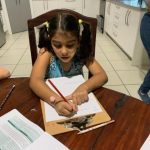
Setting goals and expectations
Suri’s learning goals of the writing task included developing knowledge of the text structure, which was a recount. Suri would develop knowledge of words and word groups (adjectives and nouns) with a clear purpose for the writing task (Fellowes & Oakley, 2019).
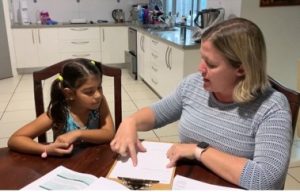
Through this writing task, Suri would receive repetition and multiple modes of exposure to literacy, through the use of the semiotic systems in the Australian Curriculum, which include listening, speaking, reading, viewing, writing and producing texts to achieve literacy progression (Australian Curriculum, Assessment and Reporting Authority [ACARA], 2018a). A clear purpose was simply articulated with Suri so she could use both her expressive and receptive oral language skills. Suri would be given choice over what to write about in her weekend recount, thereby motivating and engaging her, setting a clear purpose for the writing task and promoting a lifelong passion for reading, writing and creating texts. (Fellowes & Oakley, 2019).
Watch the video below where the goals and expectations were set.
Teaching Strategies, Literacy Strategies and Processes
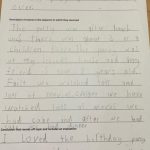
(L. Olsen, personal photograph, 28 May 2022)
The following techniques were used as an explicit guided one-on-one writing instruction lesson with Suri.
Planning framework: A planning framework that I constructed after preparing the lesson plan was given to Suri to scribe and construct her recount. The template consisted of the following headings: introduction; description of events in the sequence in which they occurred; and conclusion that rounds off topic and it included an evaluation.
Discussion of structural and language features: I discussed with Suri what she should write about in each section, and gave her explicit instructions that the description of events should include about three or four sentences. I also discussed with Suri the structural and language features of a recount as outlined in a table adapted from Fellowes & Oakley (2019, p. 399) to set expectations.
Meaning and metalanguage: The meaning and metalanguage was discussed in terms of using ‘nouns’ and ‘adjectives’ (Fellowes & Oakley, 2019).
The Lesson Plan
Lesson introduction
- Set goals and expectations
- Explain the writing task clearly and simply
Lesson development
- Use techniques identified to write in conjunction with the lesson goals
Lesson conclusion
- Re-read the text from beginning to end
- Editing of text
Assessment
- Give child feedback
- Mark achievements using recount rubric
- Expected receptive and expressive language for age group 6-8 years
The lesson plan was adapted from the modelled writing lesson plan in Fellowes and Oakley (2019, p. 476) and was used as a tool for an explicit one-on-one guided writing lesson with Suri adapted to our goals and writing. The writing task was described clearly and simply, identifying the purpose and audience to Suri.
Suri used techniques identified to write in conjunction with the lesson goals on her template that we had discussed (Fellowes & Oakley, 2019). Suri edited her text as she went through her writing lesson. She also used the writing checklist to check for grammar, spelling and language conventions.
Finally, Suri re-read her text from beginning to end to me. After she had read her recount, I drew her attention to the text structure and words and word groups identified in the lesson goals, and read her text to her with and without adjectives (Fellowes & Oakley, 2019).
I created a rubric in conjunction with the content descriptors and learning goals to assess Suri’s writing . Feedback was provided and I also reviewed her work against expected receptive and expressive language for age group 6-8 years (Fellowes & Oakley, 2019, p. 84).
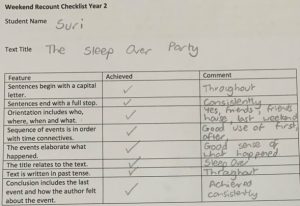
Selection and Use of Other Resources AND ICT
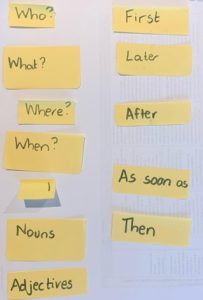
(L. Olsen, personal photograph, 28 May 2022)
The following was provided to Suri in order for her to co-construct her multimodal texts:
A recount template clearly outlining the three parts of the writing. These include the introduction; description of events in the sequence in which they occurred; and conclusion that rounds off topic.
Flash cards to remind Suri of the structural and language features we spoke about in the guided writing lesson.
A reading & writing checklist for Suri to be able to edit her writing in line with the lesson goals set-out at the beginning of the writing task, linking them to the Year 2 content descriptors assessed.
Finally, the iPad with Book Creator installed was used after the writing lesson had occurred to create a multimodal text using ICT capabilities.
Children benefit from opportunities to explore their world using technologies and to develop confidence in using digital media (Department of Education, Employment and Workplace Relations [DEEWR], 2019). Children should use ICT effectively to access, create and communicate information and ideas across the curriculum (ACARA, n.d.). The English curriculum requires children to be taught how digital texts work, and multimodal texts are part of the Australian Curriculum (Fellowes & Oakley, 2019). The ICT used in this activity aligned with the Early Years Learning Framework (EYLF) and the Australian Curriculum.
Suri was encouraged to create, save, and retrieve multimodal text for a particular purpose using the Book Creator App. The Book Creator App was chosen for Suri as it is used in the lower levels of Australian Primary Schools for children to create multimodal texts. It combines text, images, audio, photos and videos to create interactive digital stories. It has word processing capabilities to ensure alignment with Australian Curriculum English Year 2 descriptor ACELY1674 and it has the capability to share the final product as a movie. It creates motivation amongst young learners to ensure active learning and literacy progression (DEEWR, 2019). Educators of children in their early years need to create environments in which children can experience texts (spoken, written and multimodal) and experiment with them with a sense of purpose, agency and enjoyment (Fellowes & Oakley, 2019). Book Creator is also an app that has been assessed in line with the eSafety Toolkit for Schools (e-Safety Commissioner, 2021), which is designed to support schools to create safer online environments so as not to compromise Suri’s identity in this lesson.
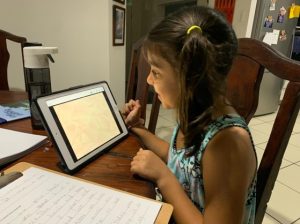
(L. Olsen, personal photograph, 28 May 2022).
Semiotic Systems & Multiliteracies Theory
Semiotic theorist de Saussure (1993, as cited in Chandler, 2017) stated that language is one form that can be combined with other systems to support meaning. Semiotic systems form part of the Australian Curriculum’s literacy modes of communication and they enhance literacy progression. The literacy modes of communication in the Australian Curriculum achieved through the recount activity were:
- Listening to instructions, lesson plan, lesson goals and expectations;
- Speaking – Suri repeating what she has heard and acknowledging she understood the instructions;
- Reading through the recount template and checklists together;
- Viewing the recount template and writing checklist together;
- Writing the weekend recount on recount template;
- Producing the multimodal text on Book Creator, which incorporated word processing, creating pictures and designs and reading back the text capabilities (ACARA, 2018)
Using a multisensory stimulus aligned with Oakley’s 2001 and 2008 electronic Language Experience Approach (e-LEA; as cited in Fellowes & Oakley, 2019) and the recount writing task involved using sound, touch, sight. Multiliteracies (Bull & Anstey, 2018) were incorporated into learning and these aligned with the EYLF, supporting children in developing a strong sense of identity and wellbeing; feeling connected to their world; and becoming confident and involved learners who communicate effectively (Hesterman, 2013).

The recount text aligned with Freebody & Luke’s (1992) sociocultural theory (as cited in Fellowes & Oakley, 2019). This can be illustrated by using the four practices to become effective readers and writers as described with the learning goals and intentions. It is necessary for educators in their early years to create environments in which children can experience texts (spoken, written and multimodal), and trial with them with agency and enjoyment (Fellowes & Oakley, 2019).
Under the social interactionist perspective, Bruner (1983) proposed that a language acquisition support system (LASS) assisted in the development of language by scaffolding more competent language users to achieve something that is not achievable independently (Fellowes & Oakley, 2019). We achieved this with Suri in completing the guided explicit one-on-one learning.
Outline of THE Child’s Learning
The specific Year 2 Australian Curriculum content descriptors linked to the writing goals identified earlier were assessed using the recount rubric developed for this writing learning experience.
Year 2 Achievement Standards evident are in bold from the weekend recount literacy activity
Receptive modes (listening, reading and viewing)
By the end of Year 2, students understand how similar texts share characteristics by identifying text structures and language features used to describe characters and events, or to communicate factual information.
They read texts that contain varied sentence structures, some unfamiliar vocabulary, a significant number of high-frequency sight words and images that provide extra information. They monitor meaning and self-correct using knowledge of phonics, syntax, punctuation, semantics and context. They use knowledge of a wide variety of letter-sound relationships to read words of one or more syllables with fluency. They identify literal and implied meaning, main ideas and supporting detail. Students make connections between texts by comparing content. They listen for particular purposes. They listen for and manipulate sound combinations and rhythmic sound patterns.
Productive modes (speaking, writing and creating)
When discussing their ideas and experiences, students use everyday language features and topic-specific vocabulary. They explain their preferences for aspects of texts using other texts as comparisons. They create texts that show how images support the meaning of the text.
Students create texts, drawing on their own experiences, their imagination and information they have learnt. They use a variety of strategies to engage in group and class discussions and make presentations. They accurately spell words with regular spelling patterns and spell words with less common long vowel patterns. They use punctuation accurately, and write words and sentences legibly using unjoined upper- and lower-case letters.
(ACARA, 2018b)
I found that in creating the weekend recount with Suri, I needed to be organised and have everything readily available and ready to go. On reflection of my latest practical experience with a Year 1 class, the need for organisation and creating a supportive learning environment was paramount. Children need to have the sense of organisation and clear expectations set out.
I found that setting clear expectations with Suri from the outset provided her with writing goals. Following and researching the writing requirements and using a planning framework, which cross-referenced to the Australian Curriculum, made the expectations clear. In addition, creating a template for Suri to work on with clearly identified goals helped make the writing a success. I also found that at the end of the explicit lesson, I asked Suri what she understood from my instructions, and she told me what she understood. Where there were a few gaps in details, I told her again.
In being familiar with the Book Creator app, and having it installed and ready to go motivated Suri to get the written part of her work done.
I think readers should avoid cumbersome tasks. The writing goals should always be specific, measurable, attainable, realistic, and timely for the age of the child. The writing should also align to the child’s strengths and interests to motivate the child to write. Writing should always be done in a quiet, organised space for the child.
I really enjoyed the experience of co-creating a multimodal text with Suri.
Key Takeaways
Make the writing process enjoyable, relatable, and aligned to the child’s
interests and ideas for a smooth writing process.
The co-constructed multimodal text
References
Australian Children’s Education & Care Quality Authority. (2011). National Quality Standard Resource List. https://www.acecqa.gov.au/nqf/national-quality-standard/quality-area-1-educational-program-and-practice
Australian Curriculum, Assessment and Reporting Authority. (n.d.). Australian Curriculum: Information and communication technology capability learning continuum [Curriculum document]. https://www.australiancurriculum.edu.au/media/1074/general-capabilities-information-and-communication-ict-capability-learning-continuum.pdf
Australian Curriculum, Assessment and Reporting Authority. (2018a). English (Version 8.4). https://www.australiancurriculum.edu.au/f-10-curriculum/english/
Australian Curriculum, Assessment and Reporting Authority. (2018b). National literacy learning progression. https://www.australiancurriculum.edu.au/media/3673/national-literacy-learning-progression.pdf
Australian Institute for Teaching and School Leadership. (2011). Australian Professional Standards for Teacher. https://www.aitsl.edu.au/teach/standards
Australians Together. (2022). First Nations kinship. https://australianstogether.org.au/discover/indigenous-culture/kinship/
Bull & Anstey (2018). Elaborating multiliteracies through multimodal texts: Changing classroom practices and developing teacher pedagogies. Routledge.
Chandler, D. (2017). Semiotics: The basics (3rd ed). Routledge.
Cracker Jack Education (2022). Teaching with Aunty: Grinding Ochre (teaching notes). https://www.crackerjackeducation.com.au/cje-content/uploads/2018/03/TWA-tools-weapons-and- utensils-year-2-grinding-ochre-teaching-notes.pdf
Department of Education, Employment and Workplace Relations. (2009). Belonging, being, becoming: The early years learning framework for Australia. https://www.education.gov.au/child-care-package/resources/early-years-learning-framework
eSafety Commissioner. (2021). Best practice framework for online safety education (Stage 2). https://www.esafety.gov.au/educators/best-practice-framework
Fellowes, J., & Oakley, G. (2019). Language, literacy and early childhood education (3rd ed.). Oxford University Press.
Goodes, A., & Laing, E. (2021). Ceremony (Teachers notes). Allen & Unwin.
Hesterman, S. (2013). Early childhood designs for multiliteracies learning. Australian Journal of Language and Literacy, 36(3), 158-68.

